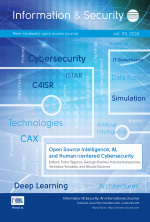Some Problems in Modeling and Simulation Area in the Bulgarian Armed Forces
Source:
Information & Security: An International Journal ,Abstract:
One of the most important lessons learned over the years is that the preparation of the officers deciding how the units should proceed is crucial. The aim, of course, is to have maximum professionalism on the level of command and control of the forces participating in each specific operation and in the behavior of each participating unit. Simulations have the potential of allowing swift and efficient staff training on different levels in the chain of command. Giving the staff access to updated information on the composition of the units and other assets available, as well as geographical data of the mission area, would provide the decision-makers with an invaluable instrument. A HQ planning operation can use databases and computers to assemble and process this information. Programming and processing information on the behavior of the different actors together with additional data creates the possibility for simulations that may produce alternative outcomes of the different actions taken by the HQ. This allows for a wider spectrum of alternative options, which will help the HQ to make better decisions. Simulations will also facilitate the processes of force generation, assessment and evolution, as well as certification of forces and assets made available for a particular operation. The purpose of this paper is to give an overview of the current state of modeling and simulation in the Bulgarian Armed Forces and of what we have to do in the near future to meet challenges in this discipline. All the ideas concerning future developments are not the formal position of the Bulgarian MoD but only reflect the author’s experience and knowledge in modeling and simulation. As a participant in already conducted Computer Assisted Exercises (CAX) in the BAF, I would like to identify and explain some problems, which occur during the development of these exercises and the creation of our models.
